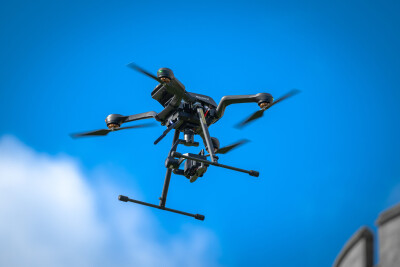With almost 10,000 kilometers of track and over 1,000 stations and stops, Austria's dense rail network is one of Europe's most punctual and safest railways. However, keeping track of infrastructure damage and route availability of such an extensive network can become troublesome. That's why, in late 2022, the Austrian Federal Railways (ÖBB) and Frequentis partnered to research hangar-based automated drone flights in Austria.
Focusing on preventing railway incidents through routine maintenance flights, ÖBB and Frequentis want to use drones to provide early detection of damage to infrastructure, natural hazard management, monitor route availability, and emergency management at major events. The idea is to create a solution for faster, more efficient, and more frequent rail track maintenance checks.
In infrastructure inspections, drones provide:
- Fast, reproducible, on-demand image acquisition.
- Accurate and comprehensive data.
- Better documentation.
- Faster reconciliation with subcontractors.
- Remote access to the current status of a site.
If deployed correctly, drone solutions can provide benefits no other tools can, especially when considering costs and time-saving. However, automated BVLOS drone flights are key to achieving the full potential and making the most out of a drone solution for a rail network this size. Unfortunately, BVLOS flights are still one of the most exceptional among drone flights, and implementing them is still a challenge from an administrative, technical, and regulatory point of view.
Together, ÖBB and Frequentis signed a unique cooperation agreement to improve the understanding of automated BVLOS drone flights and their restrictions regarding official regulations, weather, and topography, and more. Over the next 12 months, the goal is to carry out complex and automated BVLOS drone flights and test them in various railway-relevant application areas. Both companies will also explore digitalized railway operations to work out all aspects for the approval of these automated flights and to gather experience for their handling in an intensive trial operation.
"This cooperation is an important step for us," said Johann Pluy, Member of the Board of ÖBB. "With the help of BVLOS flights, we will not only increase the safety of our facilities but will also be able to handle extra tasks more frequently and at lower cost in the future. I am very excited about this promising cooperation with Frequentis."
As a UTM system developer that fully covers the services stipulated in the EASA U–Space regulation, Frequentis has vast knowledge in enhancing organizations' technological capabilities to safely and efficiently introduce drones. Last year, the Norwegian Air Navigation Services extended its existing UTM contract with Frequentis to enable safe and efficient UTM service provision around offshore platforms in the Norwegian North Sea.
Later in the year, Airservices Australia selected Frequentis to participate in a competitive down-selection process to create Australia's first Flight Information Management System (FIMS). The company is also developing Project Rise, a system that combines three independent layers of software to create an intelligent integrated system with a complete workflow of drone operations from flight planning to in-flight to post-flight auditing.
With Frequentis' help, ÖBB hopes to obtain a flight permit to enable automated drone flights from its operations center. On the other hand, Frequentis expects to gain knowledge regarding the availability, stability, regulatory requirements, and possible applications of drone hangars, which will form a valuable basis for further innovations in the field of drone technology.















Comments